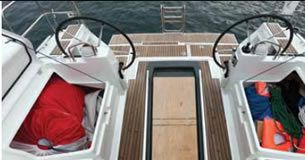
We had a cold and chilly front blow through Florida last week, which gave us an opportunity to look at something we haven’t paid much attention to in a few years: waterproofing coatings for fabrics. Textile technology has seen some significant new developments since our last complete test of waterproof coatings. Chemical engineers have found new ways to impregnate fibers with coatings that can last through dozens of wash cycles. Some new after-market spray protectants have emerged as well. The end result is clothing that — if you choose right and don’t put on too many pounds — you won’t have to think about replacing for 10-15 years, or even more.
One of the most reliable pieces of apparel in my wardrobe over the past 12 years has been a knitted polyester “technical” pullover from Gill that has followed me everywhere from fourteeners in the Rockies to winter sails on Tampa Bay. During winters in the Upper Peninsula Michigan, I wear it as a breathable, insulating base layer. Although it’s not billed as waterproof, it does a pretty good job repelling water. I like the fact that it packs very small. The model I have is discontinued, but it’s pretty similar to the OS Thermal zip, which looks identical but lacks a chest pocket (wear I keep my readers). It’s not cheap, but it is super versatile and has held up extremely well after 12 years of hard use, and still has plenty of life left.
Meanwhile, my lightweight foul weather jacket from Slam (now 10 years old since the above photo was taken) has lost all most of the interior fabric liner, and what remains is deposited behind me like bread crumbs on the dock. It still sheds water, but the velcro closures are shot and the tiny main zipper remains a pain to deal with–nearly impossible with gloves. However, it still looks good and draws the occasional “nice jacket” comment from those who don’t look to closely.
Despite all the advances in material technology, we’ve yet to see a waterproof, breathable material that doesn’t require some maintenance over time. During on-the-water testing of foul-weather gear more than a decade ago, we could clearly see how sunlight, washing, and regular use took their toll on water-repellency, in even our favorite foul-weather gear. Meanwhile, the water beaded like pearls on some of the lower-quality jackets that had spent most their time in the locker.
The unpredictable spring sailing season is just around the corner, so now is a good time to assess your own foul-weather gear. A proper treatment isn’t hard to carry out, but it does require more time than you would expect.
We’ve covered the topic of marine fabrics—from clothes to dodgers to sails—from several different angles over the years, most recently with a look at materials like Sunbrella, used in sail covers and dodgers. If you are interested in protecting the fabrics you have, or reviving your foul-weather gear, here are a couple of articles to get you started: Caring for Marine Fabrics and Water Repellents for Fabrics. You can also check out our mildew cleaner test, which is part of our three-part ebook series. Marine Cleaners, which covers everything from gelcoat repair, to boat polishes, to rust-stain removal.
If you’re thinking about a marine canvas project, dig a little deeper with our most recent fabric test, Sunbrella vs. Weathermax, and our investigation into inexpensive cordage treatments. Although it has been a very long while since we’ve looked at foul weather gear, our archive report offers some important observations that are still valid today when shopping for foul weather gear — whether it is men’s foul weather gear or women’s foul weather gear.
And if you’ve got a very smelly drysuit that has seen one-too-many frostbiting events this winter, tech editor Drew Frye offers a sure-fire way to get rid of drysuit stink. Drysuits, by the way, have become a popular alternative to foul weather gear among some sailors, especially those who spend their days in cooler climates. I touched on this previously on my blog post “Details to Look for in Drysuits for Saiors.”
Practical Sailor will be updating our test of waterproofing sprays for apparel and for boat fabrics, and I’d love to hear from readers what products they have found useful. Post your comments below for the benefit of other sailors, or email me at [email protected].








































